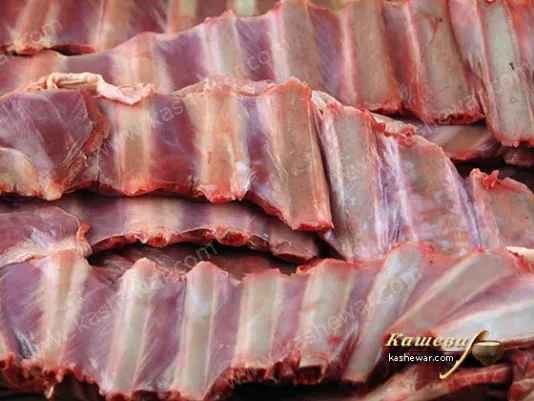Lamb Ribs with Onions
Lamb ribs with onions - a recipe for Azerbaijani cuisine, everything is very simple - ribs, onions and spices, you can cook in nature.

Lamb Ribs are a product I cook with special pleasure, as they allow working with different textures and flavors. Over the years of my practice, I’ve realized: the most important thing is the right choice and careful preparation. The meat on the ribs should be tender, with an even layer of fat that melts during heat treatment and saturates the meat with juices. I always pay attention to the color: it should be even, without dark areas or dried edges. When ribs are fresh, they immediately give off a light, slightly sweet aroma, not a sharp smell. In my experience, ribs are perfect for experimenting with spices and sauces: they absorb marinades well and create a rich aromatic profile. I know this product requires patience, but the result always justifies the time and effort, as tender, flavorful ribs remain one of the most beloved meat dishes.
In my practice, I always start by choosing quality ribs, as the final result depends on it. Fresh ribs have a light red meat color and a thin, even layer of white fat without yellowness. I always pay attention to the bones: they should be thin and light, which indicates a young lamb that gives more tender meat. If the bones are dark and massive, the meat will require longer cooking, and the flavor will be richer but less delicate. I touch the surface – it should be firm and not sticky. Smell matters a lot: quality ribs always have a pleasant, light aroma without sharpness. Over the years, I’ve learned to notice differences even in small details: too dark a cut or a dry surface means the meat has been stored too long. I always ask the butcher to cut a small piece to check the inside texture: good meat is even and juicy. For grill dishes, I choose ribs with more meat, while for braising, thinner ribs with more fat work better. The right choice affects not only taste but also the enjoyment of the cooking process.
Preparing lamb ribs is always a ritual for me. I start by removing excess fat and membranes that can make the meat tough and add bitterness. However, I always leave a thin layer of fat: it melts during cooking, keeps the juices inside, and adds characteristic flavor. In my practice, I use different marinades depending on the cooking method. For grilling, I love a mix of olive oil, garlic, rosemary, and lemon juice: it makes the meat juicy and adds freshness. For long braising, I often use marinades with wine or yogurt, which soften the fibers and create deep flavor. Marinating time is crucial: for quick searing, 2-3 hours are enough, while for roasting or braising, I leave the ribs overnight. I always add salt during marination, as it helps the meat season evenly and retain juiciness. I’ve seen many times that skipping this step leaves ribs bland and lacking character. Proper preparation is half the success.
From my experience, I know it’s the right temperature that determines whether the ribs turn tender. When I cook them in the oven, I always start at a high temperature of about 220°C (428°F) to create a crust that “seals in” the juices. Then I reduce it to 160°C (320°F) and cook slowly so the meat softens. On the grill, I use the two-zone method: first searing the ribs over direct heat for a golden crust, then moving them to the indirect heat zone to finish. This helps prevent drying out. For braising, I always keep it on low heat and add liquid – broth, wine, or tomato sauce, which bring extra depth of flavor. I’ve learned that rushing ruins the dish: at high heat, the meat becomes tough and dry. But slow, attentive cooking gives the ribs tenderness and luxurious aroma. Each method has its advantages, and I choose depending on the situation and mood.
Lamb ribs have a rich flavor, so I always choose spices that enhance it rather than overpower it. In my practice, I most often use rosemary, garlic, black pepper, and thyme: they create a harmonious aromatic profile. For marinades and sauces, lemon juice or pomegranate syrup work well, adding refreshing tanginess. I love serving ribs with yogurt-based sauces with mint or garlic, as they balance the fat of the meat. For richer options, I use tomato or wine sauces, which make the dish deeper and more expressive. I choose simple sides: roasted vegetables, potatoes, or rice complement the lamb flavor perfectly. From experience, I know that excessive or overly bright ingredients only distract, so I always follow the principle of balance. The result is a harmonious dish, where ribs remain the main star, and everything else just highlights their flavor.
Over the years, I’ve seen many mistakes with lamb ribs. The most common is overdrying due to too high a temperature. To avoid this, I always use combined methods: first a crust, then slow finishing. Another issue is excess fat: if it’s not trimmed, the dish becomes heavy and harsh. But completely removing the fat strips the ribs of character, so I leave a thin layer. I often see mistakes with marination: some use too many spices, and they mask the natural flavor of the meat. I always emphasize: lamb loves balance, a few well-chosen accents work better than a complex mix. Another problem is rushing the serving: if you cut the ribs immediately after roasting, the juices escape, and the meat becomes dry. I always let it “rest” under foil for 10-15 minutes, and the result is impressive. In my experience, it’s attention to detail that guarantees success, and lamb ribs reward with tenderness and luxurious taste.